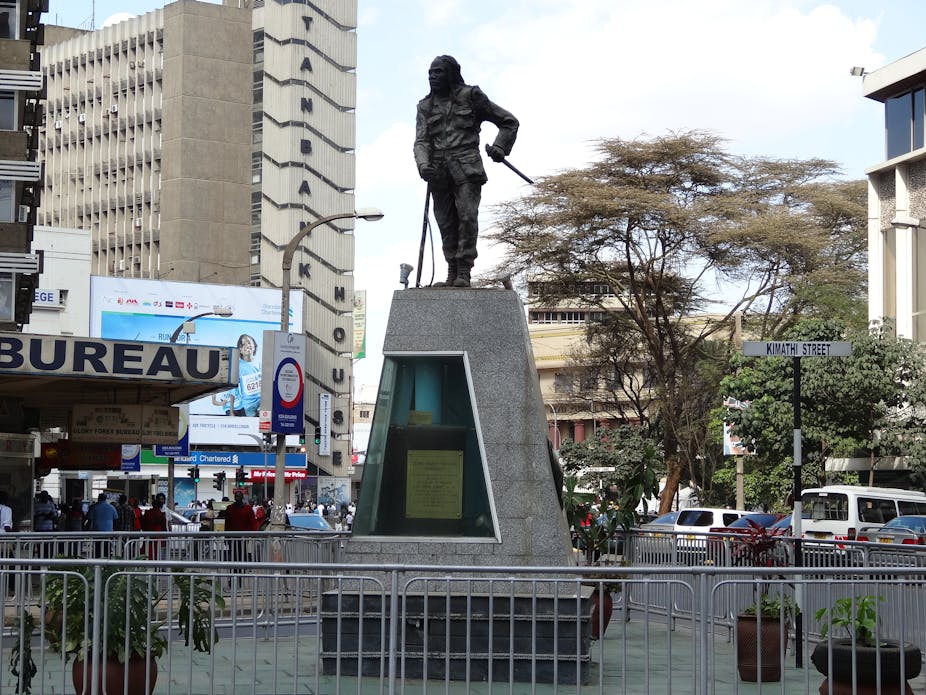For 40 years, successive Kenyan governments turned their back on the Mau Mau. The armed movement sprang up in the early 1950s in protest over colonial land alienation, economic inequalities and political oppression under British rule. Outlawed in 1952, it was crushed in a brutal campaign in which more than 10,000 Mau Mau fighters were killed. Its leader, Dedan Kimathi, was killed in 1957.
A few years later, in 1963, Kenya became independent with Jomo Kenyatta as founding leader. The new government was made up of so-called “moderates”, rather than the “radicals” who had supported Mau Mau claims.
Kenyatta’s relationship to the movement was ambiguous. The British arrested him in 1952 on suspicion of being one of its leaders. But after independence his pleas to “forgive and forget the past” were often accompanied by a clear dissociation from the Mau Mau. He continued to describe them as a “disease” and they remained banned under Kenyatta and his successor Daniel arap Moi.
In 2003 Kenya’s third president, Mwai Kibaki, lifted the ban on the movement. For many, the 40-year clampdown meant its contribution to Kenyan independence had been actively erased from national memory since independence.
Though the reasons why the successive Kenyan governments did not want to talk about Mau Mau history are no longer a mystery, one question remains: why did the resilient Mau Mau freedom fighters fail to maintain revolutionary action after independence?
The research I conducted for my book, Power and the Presidency in Kenya: the Jomo Kenyatta Years, 1958-1978, suggests some reasons.
Mau Mau resilience
My attention to Mau Mau post-colonial history was first caught by an archival file held in the Kenyan National Archives. In it were various intelligence reports received by the provincial commissioner of the (then) Eastern Province, Eliud Mahihu, around the years 1964 and 1965.
Based on these reports, Meru district stood out as a particularly sensitive area. There, Mau Mau fighters holed up in the forests refused to surrender. Whereas virtually all Mau Mau leaders had either been killed or coopted in what was then Central Province, fighters in Meru held firm. Field Marshal Mwariama, Field Marshal Baimungi Marete and General Chui (originally from Central Province) were among them.
Their actions and movements were closely monitored by security officers and informers. The government’s fear was that if not dispersed from their forest camp, the remaining fighters and recently released Mau Mau detainees would form a separate movement. The revival of Mau Mau was a threat to the new political order.
Archival files document how the Kenyan government was trying to neutralise resilient Mau Mau fighters. Ministers and government officials repeatedly toured Meru district offering amnesty for those who would surrender. Police action to clear the forest risked being highly unpopular and even unproductive.
In the end the government chose to coopt remaining leaders, or target them. Mwariama finally surrendered early in 1964. The government hoped to use him as an intermediary to negotiate with Baimungi and Chui – in vain.
This resilience risked strengthening the voice of the populist opposition, whose main demand was that land alienated by colonisers be redistributed for free. The government, on the other hand, was driving its land policy of “willing buyer, willing seller”.
On 26 January 1965 Baimungi and Chui were both killed by police.

Ambiguous relationship
The story did not end in 1965. Silencing the Mau Mau movement was also about sending subtle but powerful messages to the restive Meru population. A member of their tribe, Jackson Angaine, held the powerful position of Minister for Lands.
As the archives reveal, Angaine was in close contact with both provincial commissioner Mahihu and President Kenyatta about the situation in Meru. But the archives did not reveal much about the relationship between Angaine and the Mau Mau, so I decided to find out more through field work. Meru politicians who had been active in the 1960s and Mau Mau veterans filled out the picture. They helped me to situate Angaine within Meru politics.
In 1954, Angaine was arrested and briefly detained by the colonial authorities. It remains unclear whether this was primarily because he was suspected of belonging to the Mau Mau movement, or because he was accused of the murder of his wife. He was acquitted for lack of proof.
Still, his detention helped to establish him as a follower of the movement. Kenyatta certainly knew that, just like himself, Angaine had an ambiguous relationship to the Mau Mau movement. Appointing him as Minister for Lands would send a positive message to the Meru people. They would believe that the minister in charge of land redistribution was a local follower of the movement.
And so the “willing buyer, willing seller” land policy could quietly go on. The British government was relieved that there would no radical land redistribution that could undermine its interests in Kenya. The new Kenyan government officials could get British loans to buy colonial land and strengthen their control over the country’s main economic resource. Left out of the equation were the landless poor people who would have to wait longer for the promise of land to be fulfilled.
This article is based on the research I conducted for my book, Power and the Presidency in Kenya: the Jomo Kenyatta Years, 1958-1978 (Cambridge University Press, 2020).

